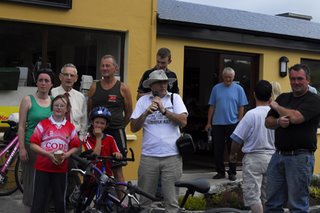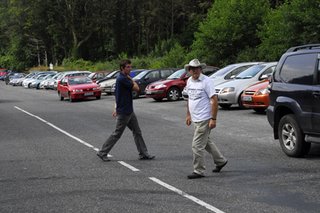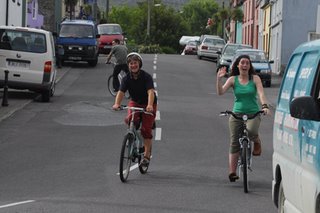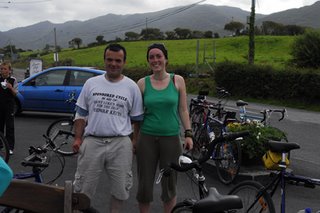Thursday, November 09, 2006
Thursday, October 12, 2006
The O'Briens postcards have finally appeared! If you live near an O'Briens Sandwich Bar have a look for the free postcard stand, you'll spot the one taken in Lodwar immediately!
http://www.obriens.ie/MAIN/Promotions/photography/2006.asp
http://www.obriens.ie/MAIN/Promotions/photography/2006.asp
Thursday, August 31, 2006
Tuesday, August 29, 2006
Dear Barry,
Greetings from Lodwar.
Thanks for your email and nice pictures.
We appreciate it very much that you have planned a cycle cross again on August 27, 2006 in support of St. Lukes School and Home for Deaf Children, Lodwar, Turkana, Kenya
Your slogan to the sponsors is right : your small change can make a big change in Lodwar, Turkana.
The deaf children like to go to school, they are eager to learn. In the Home "St. Luke" all staff (and children) are "working" well and with pleasure and that is very important.
You know last year we finished our buildings: a studyroom with a library on the compound of the Home and we extended the compound of the Home and you have seen the new nursery. Two classrooms and a staffroom with store. We admitted 18 deaf children and all is going well. For the library we bought some books, we bought furniture for the nursery classrooms, for protection we installed three streetlights, but we did not finish all solar installation in the buildings of St Luke's Home for the deaf.
Herewith separate a few pictures.
Barry for now kind regards, also from Annie and greetings to your wife and relatives and the people who are sponsoring this project.
Also on behalf of the staff and the children.
Ben Janssen.




Greetings from Lodwar.
Thanks for your email and nice pictures.
We appreciate it very much that you have planned a cycle cross again on August 27, 2006 in support of St. Lukes School and Home for Deaf Children, Lodwar, Turkana, Kenya
Your slogan to the sponsors is right : your small change can make a big change in Lodwar, Turkana.
The deaf children like to go to school, they are eager to learn. In the Home "St. Luke" all staff (and children) are "working" well and with pleasure and that is very important.
You know last year we finished our buildings: a studyroom with a library on the compound of the Home and we extended the compound of the Home and you have seen the new nursery. Two classrooms and a staffroom with store. We admitted 18 deaf children and all is going well. For the library we bought some books, we bought furniture for the nursery classrooms, for protection we installed three streetlights, but we did not finish all solar installation in the buildings of St Luke's Home for the deaf.
Herewith separate a few pictures.
Barry for now kind regards, also from Annie and greetings to your wife and relatives and the people who are sponsoring this project.
Also on behalf of the staff and the children.
Ben Janssen.




Monday, August 28, 2006
Wednesday, August 23, 2006
Program Education for Deaf in Lodwar (Kenya)
DIOCESE OF LODWAR, P.O.BOX 101, LODWAR, KENYA
Proposal: Turkana Unit for Deaf in an existing primary school in Lodwar
A. Basic project data.
1 . Turkana unit for Deaf in Lodwar (Kenya)
2. Location of the Project: In the north of Kenya, District Turkana, Lodwar.
3. Agency requesting funding: the Authority:
The Bishop of the Diocese of Lodwar Rev. P Harrington, SMA
Private Bag, Lodwar, Kenya, tel: 0393-21055, fax: 0393-21417
4. The executive authority is the Principal of the Centre.
5. Type of community: both urban and rural.
6. Scope: Community consisting of whole Diocese of Lodwar -- District of Turkana
7. Target group - Deaf and hearing impaired children
8. Education for children of 4-16 years
9. Duration of the project: ongoing. Starting: Second term 2002
10. Contact person: Ben Janssen, P.O. Box 10 1, Lodwar, Tel 0393-21474
11. Kenya Commercial Bank, Lodwar, Acc. Nr 27.66.20.761
B. Short summary of the project
General description of the area: Background of Turkana
Turkana is the largest district in Kenya, occupies the area of north western Kenya to the west of Lake Turkana. The district covers a total area of 77,000 km. It shares to the north and west international boundaries with Ethiopia, Sudan and Uganda. The 1999 national census population of Turkana district is 447,000 people. 70% of those are pastoralist (nomads).
What kind of region
Much of the heartland of Turkana is desert or semi desert terrain with scant rainfall. "Through the punishing heat and the sandy and rocky terrain it is one of the harshest regions of Africa". Nigell Pavit, Book: "Turkand'. The altitude of Turkana District is between 600 and 900 meters above the sea level. It has an annual rainfall average of about 300-400 mm falling to less than 150mm in the and central regions. It is a very poor part of the country.
Lodwar is the capital of the Turkana District and it has about 30.000 inhabitants. The centre for Deaf will be situated in Lodwar. At the outskirts of the town in the village of Nakwamekwi. The Primary school is Loyo Primary School.
What kind of people are living in Turkana?
The region is sparsely populated by the Turkana. They have about 440.000 inhabitants. They are one of the last nomadic peoples of Africa. The women build houses of palm leaves and make trays , baskets and utensils from palm. leaves. They sell their products mainly in Lodwar town. Their land is too remote and too dry to be attractive to outsiders Life is very hard and the people have to survive, with their livestock of sheep, goats and camels.
Agriculture and industry
On both sides of the river Turkwell we see attempts at growing maize and millet etc. However the harvest is very poor because the soil is salty and there is no fertiliser. There is one "tarmac" road from the south (Kitale) to the north (the border of Sudan), especially for transporting food to the Sudan. There is no big industry. There are some carpenters and other craftsmen who works in small workshops but many of these come from "down country" Kenya - not from Turkana itself. The district gets little support from the central government. The ethnic group is the Turkana. They are mostly (above 70 %) still traditional nomadic shepherds. Because of the drought and general poverty there is quite a lot of migration to the towns, especially to Lodwar.
Schools
There are about 147 primary and 6 secondary schools in the Diocese of Lodwar. There is one polytechnic in Lodwar, mainly for boys. In Kakuma town in North of Turkana there is a Centre for vocational training for girls "Turkana Homecraft Centre".
Educational level and facilities:
There are primary and secondary government schools. Education is very expensive for the Turkana children. There are day schools mainly in town (Lodwar, Kakuma.) and boarding schools mainly in the bush.
They use the English system of education and the children need:
uniforms
books and exercise books and other materials
school fees The number of pupils in a class in town schools is very high; sometimes 40 to 60 children in one group. In the schools outside the towns there are very small classes of children sometimes less than 20.
Most of the children who attend schools are sponsored. The parents are not able to pay school fees. A lot of parents can't afford the fees, so there are many children who don't go to school. Primary school is in theory free education but in practice various different levies means that amount have to be paid.
Schools for handicapped pupils.
In Katilu there is a blind integrated school founded and sponsored by the Diocese of Lodwar.Otherwise there are no schools in Turkana of special education for handicapped children.
So there are no schools for deaf children in Turkana. Some hearing impaired children are going to a school for deaf in Webuye, about 400 km South of Lodwar. But the insecurity is very high; the road is very bad, the costs for transport are high, and it is far outside their home district area (environment), etc. So there is a lack of education for deaf people in Turkana. Therefore the Diocese is willing to begin education and help to hearing impaired and deaf children by starting a unit for deaf at a Primary Mission school.
Some causes of deafness in Turkana.
In this area there are many cases of malaria and the treatment for the most severe cases is quinine. A complication of treatment with quinine is temporary deafness and sometimes (total) deafness. Other causes of deafness are meningitis and also deafness can occur as a complication of whooping cough and measles. The parents because of shame often hide deaf children.
Brief description of help to deaf
The Project.
The request of the Bishop of the Diocese of Lodwar is to realise education for deaf children. First stage: Our purpose is to develop an education program for hearing impaired and deaf children in co-operation with a sponsored school of the Diocese. The students will follow/ attend lessons in a separate unit at a primary school during normal school time.
At the primary school the pupils will get the basic skills, knowledge and attitudes which can applied in day- to- day living to improve the quality of life of an individual and the society in which she/he lives.
In the syllabi and regulations of Special education we find the Specific Objectives, subjects, topics, hours, etc.
The subjects will be taught in the following levels:
a) Pre-primary: nursery class (3/4) and infant class (5/6)
b) Primary level: lower primary and upper primary
"The aim of the Development and Survival Skills as a subject is to equip deaf learners with skills that will enable them to live a whole life not withstanding the hearing loss."
After lessons in the morning they will get extra guiding and help in the afternoon in their "Home", belonging to the church and about 1 km away.
Subjects to be taught: - sign language
- speak readiness (preparing themselves to be able/ready to speak)
- articulation readiness (preparing themselves to articulate themselves)
- auditory training
After supper they will go home or to a host family (when possible and needed)
So the first stage is education to children from Lodwar and nearby for deaf) on the same school compound. Teaching will be given separately and breaks will be at the same time for all the children. All children need a test in an assessment centre before admittance. Later on the second stage is education for children with impaired hearing and deaf children of the whole Diocese with facilities in the "Home' belonging to the church. This will make it possible to provide day and night care for the children in separate classes.
Aim of the Project:
To locate hearing impaired and deaf children
To enhance/support/encourage the hearing impaired/deaf child to operate as independently as possible. This will be done through specially adapted education, coaching, guidance and counselling.
Education, supervision and treatment of prelingually deaf children. "prelingual" meaning that the deafness has arisen before the age at which speech is normally fairly well developed).
Guidance of parents and relatives regarding/concerning the hearing impaired/deaf child.
Giving advice concerning deafness to people involved.
Admittance:
Hairing impaired and deaf children of 4 up to 15 years of all denominations. Entrance: interview and "suitability test". Careful diagnosis is of great importance for establishing the degree of deafness and the child's development capacity as early as possible. The child's hearing will be examined and if possible he or she will be measured for the correct hearing aid.
Religion:
The education is based on Christian principles/faith. Other religions and cultures will be treated/dealt with having respect for their religious beliefs.
The project for deaf is an initiative of the Diocese and is small-scale in nature
DIOCESE OF LODWAR, P.O.BOX 101, LODWAR, KENYA
Proposal: Turkana Unit for Deaf in an existing primary school in Lodwar
A. Basic project data.
1 . Turkana unit for Deaf in Lodwar (Kenya)
2. Location of the Project: In the north of Kenya, District Turkana, Lodwar.
3. Agency requesting funding: the Authority:
The Bishop of the Diocese of Lodwar Rev. P Harrington, SMA
Private Bag, Lodwar, Kenya, tel: 0393-21055, fax: 0393-21417
4. The executive authority is the Principal of the Centre.
5. Type of community: both urban and rural.
6. Scope: Community consisting of whole Diocese of Lodwar -- District of Turkana
7. Target group - Deaf and hearing impaired children
8. Education for children of 4-16 years
9. Duration of the project: ongoing. Starting: Second term 2002
10. Contact person: Ben Janssen, P.O. Box 10 1, Lodwar, Tel 0393-21474
11. Kenya Commercial Bank, Lodwar, Acc. Nr 27.66.20.761
B. Short summary of the project
General description of the area: Background of Turkana
Turkana is the largest district in Kenya, occupies the area of north western Kenya to the west of Lake Turkana. The district covers a total area of 77,000 km. It shares to the north and west international boundaries with Ethiopia, Sudan and Uganda. The 1999 national census population of Turkana district is 447,000 people. 70% of those are pastoralist (nomads).
What kind of region
Much of the heartland of Turkana is desert or semi desert terrain with scant rainfall. "Through the punishing heat and the sandy and rocky terrain it is one of the harshest regions of Africa". Nigell Pavit, Book: "Turkand'. The altitude of Turkana District is between 600 and 900 meters above the sea level. It has an annual rainfall average of about 300-400 mm falling to less than 150mm in the and central regions. It is a very poor part of the country.
Lodwar is the capital of the Turkana District and it has about 30.000 inhabitants. The centre for Deaf will be situated in Lodwar. At the outskirts of the town in the village of Nakwamekwi. The Primary school is Loyo Primary School.
What kind of people are living in Turkana?
The region is sparsely populated by the Turkana. They have about 440.000 inhabitants. They are one of the last nomadic peoples of Africa. The women build houses of palm leaves and make trays , baskets and utensils from palm. leaves. They sell their products mainly in Lodwar town. Their land is too remote and too dry to be attractive to outsiders Life is very hard and the people have to survive, with their livestock of sheep, goats and camels.
Agriculture and industry
On both sides of the river Turkwell we see attempts at growing maize and millet etc. However the harvest is very poor because the soil is salty and there is no fertiliser. There is one "tarmac" road from the south (Kitale) to the north (the border of Sudan), especially for transporting food to the Sudan. There is no big industry. There are some carpenters and other craftsmen who works in small workshops but many of these come from "down country" Kenya - not from Turkana itself. The district gets little support from the central government. The ethnic group is the Turkana. They are mostly (above 70 %) still traditional nomadic shepherds. Because of the drought and general poverty there is quite a lot of migration to the towns, especially to Lodwar.
Schools
There are about 147 primary and 6 secondary schools in the Diocese of Lodwar. There is one polytechnic in Lodwar, mainly for boys. In Kakuma town in North of Turkana there is a Centre for vocational training for girls "Turkana Homecraft Centre".
Educational level and facilities:
There are primary and secondary government schools. Education is very expensive for the Turkana children. There are day schools mainly in town (Lodwar, Kakuma.) and boarding schools mainly in the bush.
They use the English system of education and the children need:
uniforms
books and exercise books and other materials
school fees The number of pupils in a class in town schools is very high; sometimes 40 to 60 children in one group. In the schools outside the towns there are very small classes of children sometimes less than 20.
Most of the children who attend schools are sponsored. The parents are not able to pay school fees. A lot of parents can't afford the fees, so there are many children who don't go to school. Primary school is in theory free education but in practice various different levies means that amount have to be paid.
Schools for handicapped pupils.
In Katilu there is a blind integrated school founded and sponsored by the Diocese of Lodwar.Otherwise there are no schools in Turkana of special education for handicapped children.
So there are no schools for deaf children in Turkana. Some hearing impaired children are going to a school for deaf in Webuye, about 400 km South of Lodwar. But the insecurity is very high; the road is very bad, the costs for transport are high, and it is far outside their home district area (environment), etc. So there is a lack of education for deaf people in Turkana. Therefore the Diocese is willing to begin education and help to hearing impaired and deaf children by starting a unit for deaf at a Primary Mission school.
Some causes of deafness in Turkana.
In this area there are many cases of malaria and the treatment for the most severe cases is quinine. A complication of treatment with quinine is temporary deafness and sometimes (total) deafness. Other causes of deafness are meningitis and also deafness can occur as a complication of whooping cough and measles. The parents because of shame often hide deaf children.
Brief description of help to deaf
The Project.
The request of the Bishop of the Diocese of Lodwar is to realise education for deaf children. First stage: Our purpose is to develop an education program for hearing impaired and deaf children in co-operation with a sponsored school of the Diocese. The students will follow/ attend lessons in a separate unit at a primary school during normal school time.
At the primary school the pupils will get the basic skills, knowledge and attitudes which can applied in day- to- day living to improve the quality of life of an individual and the society in which she/he lives.
In the syllabi and regulations of Special education we find the Specific Objectives, subjects, topics, hours, etc.
The subjects will be taught in the following levels:
a) Pre-primary: nursery class (3/4) and infant class (5/6)
b) Primary level: lower primary and upper primary
"The aim of the Development and Survival Skills as a subject is to equip deaf learners with skills that will enable them to live a whole life not withstanding the hearing loss."
After lessons in the morning they will get extra guiding and help in the afternoon in their "Home", belonging to the church and about 1 km away.
Subjects to be taught: - sign language
- speak readiness (preparing themselves to be able/ready to speak)
- articulation readiness (preparing themselves to articulate themselves)
- auditory training
After supper they will go home or to a host family (when possible and needed)
So the first stage is education to children from Lodwar and nearby for deaf) on the same school compound. Teaching will be given separately and breaks will be at the same time for all the children. All children need a test in an assessment centre before admittance. Later on the second stage is education for children with impaired hearing and deaf children of the whole Diocese with facilities in the "Home' belonging to the church. This will make it possible to provide day and night care for the children in separate classes.
Aim of the Project:
To locate hearing impaired and deaf children
To enhance/support/encourage the hearing impaired/deaf child to operate as independently as possible. This will be done through specially adapted education, coaching, guidance and counselling.
Education, supervision and treatment of prelingually deaf children. "prelingual" meaning that the deafness has arisen before the age at which speech is normally fairly well developed).
Guidance of parents and relatives regarding/concerning the hearing impaired/deaf child.
Giving advice concerning deafness to people involved.
Admittance:
Hairing impaired and deaf children of 4 up to 15 years of all denominations. Entrance: interview and "suitability test". Careful diagnosis is of great importance for establishing the degree of deafness and the child's development capacity as early as possible. The child's hearing will be examined and if possible he or she will be measured for the correct hearing aid.
Religion:
The education is based on Christian principles/faith. Other religions and cultures will be treated/dealt with having respect for their religious beliefs.
The project for deaf is an initiative of the Diocese and is small-scale in nature
Tuesday, August 15, 2006
In support of St. Lukes School and Home for Deaf Children, Lodwar, Turkana, Kenya
This is the 6th Annual Cycle from Castletownbere to Kenmare which will be held on August 27th in support of the above project, which is in Bishop Padraig Harrington’s diocese of Lodwar, Turkana, North Kenya.
So far, your support has helped build a home and a school where these children can live and gain an education that would otherwise be unavailable to them. Some travel over a 100 miles on foot to try and get a place in this facility and a chance for a better future.
So remember, your small change can make a big change in Lodwar, Turkana
http://turkanalodwar.blogspot.com
PLEASE SUPPORT
AIB Castletownbere 10904001
Contact: Barry Harrington, 085 7397896 or 027 60900
oldbankseafoodrest@ireland.com


















This is the 6th Annual Cycle from Castletownbere to Kenmare which will be held on August 27th in support of the above project, which is in Bishop Padraig Harrington’s diocese of Lodwar, Turkana, North Kenya.
So far, your support has helped build a home and a school where these children can live and gain an education that would otherwise be unavailable to them. Some travel over a 100 miles on foot to try and get a place in this facility and a chance for a better future.
So remember, your small change can make a big change in Lodwar, Turkana
http://turkanalodwar.blogspot.com
PLEASE SUPPORT
AIB Castletownbere 10904001
Contact: Barry Harrington, 085 7397896 or 027 60900
oldbankseafoodrest@ireland.com




























